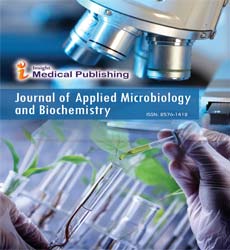ISSN : ISSN: 2576-1412
Journal of Applied Microbiology and Biochemistry
Proteomics in Microbial Research From Disease Mechanisms to Biofuels
Aleksandra Soledad*
Department of Microbiology, Heidelberg University, Heidelberg, Germany
- *Corresponding Author:
- Aleksandra Soledad
Department of Microbiology, Heidelberg University, Heidelberg,
Germany, E-mail: aleksandraSole00@gmail.com
Received date: September 27, 2024, Manuscript No. IPJAMB-24-19871; Editor assigned date: September 30, 2024, PreQC No. IPJAMB-24-19871 (PQ); Reviewed date: October 14, 2024, QC No. IPJAMB-24-19871; Revised date: October 21, 2024, Manuscript No. IPJAMB-24-19871 (R); Published date: October 28, 2024, DOI: 10.36648/2576-1412.8.5.249
Citation: Soledad A (2024) Proteomics in Microbial Research From Disease Mechanisms to Biofuels. J Appl Microbiol Biochem Vol. 8 No.5:249.
Description
Proteomics is the general study of proteins and is an important branch of molecular biology that aims to understand the structure, function and interaction of proteins in biological systems. As a function of cells, proteins play an important role in almost all biological processes. Advances in proteomics have improved our understanding of disease, drug development and biomarker discovery. This article provides an in-depth look at proteomics research methods and their applications that are important in modern science.
Proteomic techniques
The study of microbial proteomes involves several sophisticated methodologies, primarily revolving around Mass Spectrometry (MS) and Liquid Chromatography coupled with Mass Spectrometry (LC-MS). These techniques enable the identification, quantification and characterization of proteins in complex microbial samples. Mass spectrometry is a fundamental of proteomics, allowing for the rapid analysis of thousands of proteins from a single sample. In microbial studies, proteins are often extracted from cells, digested into peptides using proteolytic enzymes like trypsin and analysed via MS. Advanced MS techniques, such as andem Mass Spectrometry (MS), provide high-resolution data that can differentiate between closely related protein isoforms and detect Post-Translational Modi-fications (PTMs) that are critical for microbial function and regulation. Liquid chromatography plays a complementary role, enhancing the separation of complex protein mixtures before MS analysis. Techniques like Reverse-Phase Liquid Chromatography (RPLC) facilitate the separation of peptides based on their hydrophobicity, thus improving the sensitivity of subsequent MS detection. Moreover, the integration of online sample preparation methods, such as peptide desalting and enrichment, has streamlined the workflow, making it possible to analyse more complex samples efficiently. In addition to MS and LC-MS, Two-Dimensional gel Electrophoresis (2-DE) remains a valuable method, especially for visualizing protein expression profiles across different conditions. Though it has limitations, such as difficulty in resolving very large or hydrophobic proteins, 2-DE allows researchers to detect changes in protein expression due to environmental stressors, growth phases, or pathogenic interactions.
However, the interpretation of proteomic data is complex and requires robust bioinformatics tools to analyse large datasets effectively. Software packages for protein identification, quantification and pathway analysis are essential for translating raw data into meaningful biological insights.
Biomedical proteomics
The applications of proteomics in microbiology are vast and transformative, impacting areas such as microbial physiology, pathogenesis and biotechnology. One significant application is the identification of virulence factors in pathogenic microorganisms. By comparing the proteomes of virulent and avirulent strains, researchers can pinpoint specific proteins that contribute to pathogenicity. For instance, studies on Escherichia coli and Staphylococcus aureus have revealed key proteins involved in adherence, invasion and immune evasion, prepare for novel therapeutic targets. Another critical area is the investigation of microbial interactions within complex communities, such as biofilms or the human microbiome. Proteomic approaches enable researchers to study the dynamic protein expression profiles of microbial communities in response to environmental changes, such as nutrient availability or antibiotic treatment. Understanding these interactions at the proteomic level can elucidate the mechanisms underlying biofilm formation, antibiotic resistance and community stability, ultimately informing strategies for managing microbial populations in clinical and environmental settings. In biotechnology, proteomics plays a pivotal role in optimizing microbial strains for industrial applications. By analyzing the proteomes of microorganisms involved in fermentation processes, researchers can identify rate-limiting steps and enhance the production of valuable metabolites, such as antibiotics, enzymes, or biofuels. Proteomic profiling can also aid in the engineering of microbes for improved performance, including enhanced yield or resistance to inhibitors. Moreover, proteomics has significant implications in vaccine development. By identifying immunogenic proteins through proteomic analysis, researchers can design more effective vaccines targeting specific microbial pathogens. This approach has shown potential in developing vaccines against diseases such as tuberculosis and malaria, where traditional vaccine strategies have been challenging. Despite its advancements, microbial proteomics faces several challenges. The complexity of microbial proteomes, particularly in mixed cultures, can complicate analyses. Additionally, the vast diversity of microbial life necessitates the development of personalized methodologies to study specific organisms or environments. Future advancements in single-cell proteomics and high-throughput sequencing technologies are likely to address these challenges, enabling deeper insights into microbial protein dynamics. In conclusion, proteomics has emerged as a powerful tool in microbiology, offering unparalleled insights into the roles of proteins in microbial life. With ongoing advancements in methodologies and applications, proteomics potential to improve our understanding of microbial physiology, pathogenesis and ecology, ultimately leading to innovative solutions for global health and environmental challenges.
Open Access Journals
- Aquaculture & Veterinary Science
- Chemistry & Chemical Sciences
- Clinical Sciences
- Engineering
- General Science
- Genetics & Molecular Biology
- Health Care & Nursing
- Immunology & Microbiology
- Materials Science
- Mathematics & Physics
- Medical Sciences
- Neurology & Psychiatry
- Oncology & Cancer Science
- Pharmaceutical Sciences
